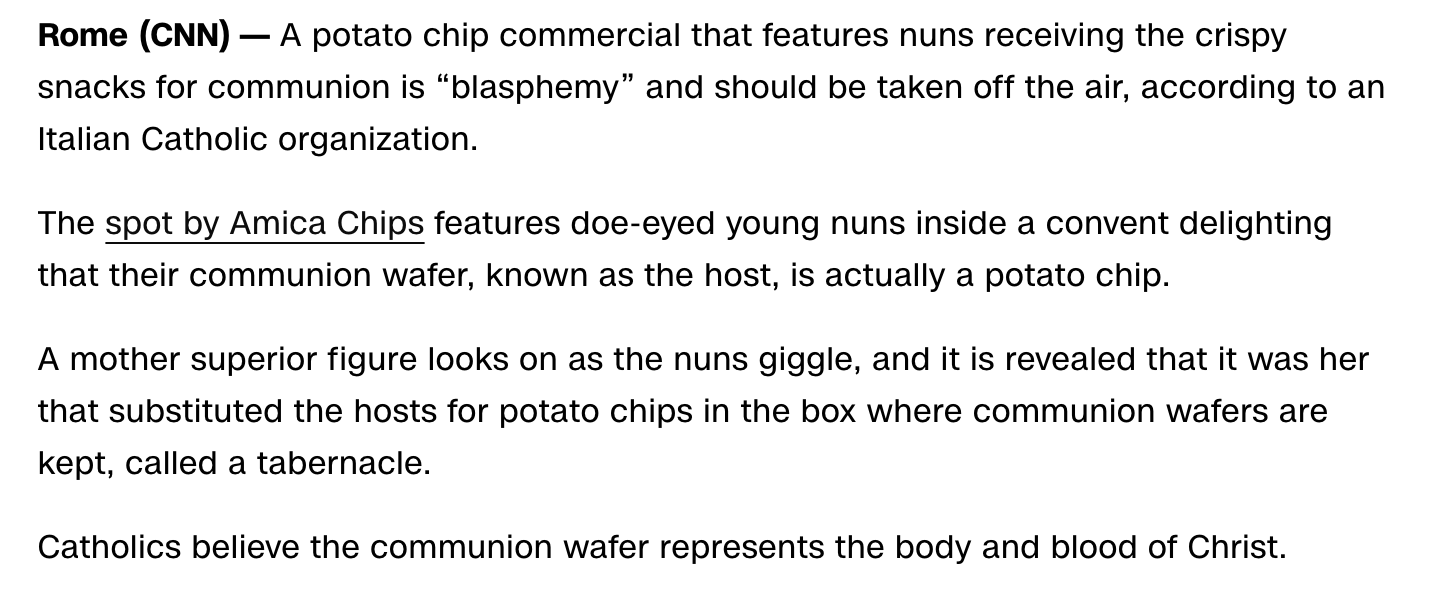FACT CHECK: Do Catholics Believe Communion Wafer ‘Represents’ Christ’s Blood And Body?
CNN claimed in an April 10 article that Catholics believe that communion wafers “represents the body and blood of [Jesus] Christ.”

Screenshot/CNN
Verdict: Misleading
The Catholic Church teaches that communion wafers become the actual blood and body of Christ through a process called transubstantiation. It is not merely a symbol, according to the Catholic Church.
Fact Check:
CNN reported in an April 10 article about a controversial potato chip commercial that features nuns comparing the chips to a communion wafer. The article claims that “Catholics believe the communion wafer represents the body and blood of Christ.”
This is misleading. The Catholic Church does not believe that the communion wafer, also known as the bread, “represents” Christ’s body and blood. The Catholic Church’s Catechism states that “the heart of the Eucharistic celebration are the bread and wine that, by the words of Christ and the invocation of the Holy Spirit, become Christ’s Body and Blood.”
The Catholic Church does not believe that the body and blood of Christ, otherwise known as the Eucharist, are just symbols of Christ, according to the United States Conference of Catholic Bishops. The USCCB states that the Eucharist is “truly the Body and Blood of Christ and are not merely symbols.”
“When Christ said ‘This is my body’ and ‘This is my blood,’ the bread and wine are transubstantiated. Though the bread and wine appear the same to our human faculties, they are actually the real body and blood of Jesus,” the USCCB states.
“The Catholic Church teaches that in the celebration of the Eucharist, bread and wine become the Body and Blood of Jesus Christ,” Chieko Noguchi, the spokesperson for the USCCB, told Check Your Fact in an email.
The USCCB also released a document titled “The Mystery of the Eucharist in the Life of the Church” in January 2022 about the Eucharist. (RELATED: Did Pope Francis Say That Jesus Was Born During A Census Taken By King David?)
The document, in the subsection titled “The Real Presence of Christ,” states:
“From the very beginning, the Church has believed and celebrated according to the teaching of Jesus himself: Whoever eats my flesh and drinks my blood has eternal life and I will raise him on the last day. For my flesh is true food, and my blood is true drink. Whoever eats my flesh and drinks my blood remains in me and I in him (Jn 6:54-56). It is not ‘ordinary bread and ordinary drink’ that we receive in the Eucharist, but the flesh and blood of Christ, who came to nourish and transform us, to restore our relationship to God and to one another.”
A CNN spokesperson told Check Your Fact “that the story has been updated with a correction included.” The story’s updated copy reads, “The Catholic Church teaches the communion is the body and blood of Christ.”
“Correction: An earlier version of this story incorrectly stated Catholic doctrine about the eucharist. The Catholic Church teaches communion wafers are transubstantiated into the blood and body of Jesus,” the correction reads.
A 2019 Pew Research survey found that only one-third of U.S. Catholics believe that the Eucharist contains the real presence (i.e., the body and blood) of Christ. 63% of Catholics who attend Mass on a weekly basis believe that the Eucharist contains the real presence, according to the survey.
A 2023 report from Georgetown University’s Center for Applied Research in the Apostolate (CARA) found that nearly two-thirds of U.S. Catholics believed in the real presence, according to Catholic News Agency. The CARA report said that there were problems with the way the Pew Research survey asked the question of the real presence, the outlet reported.
Update 04/16/2024: This article has been updated with a response from the USCCB.
